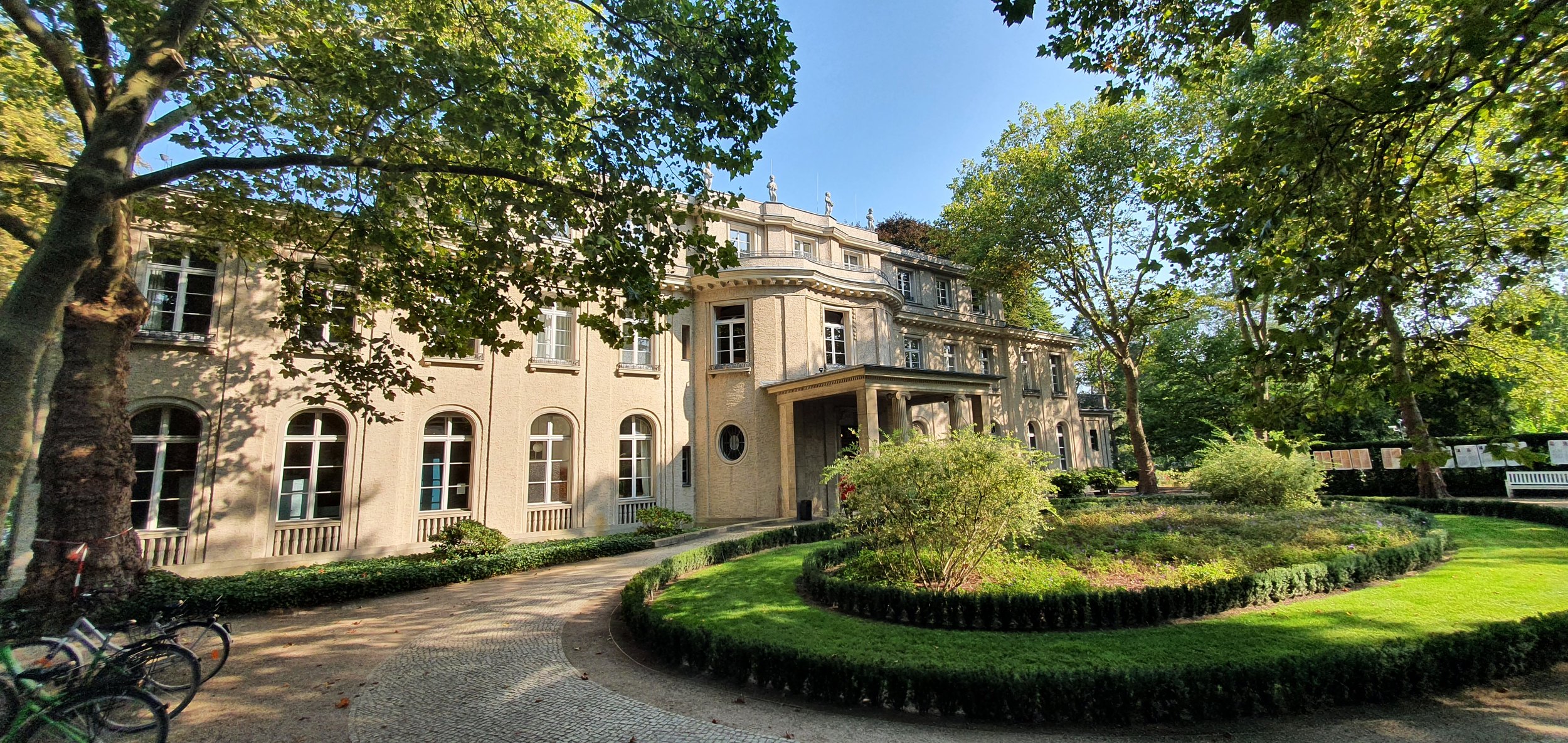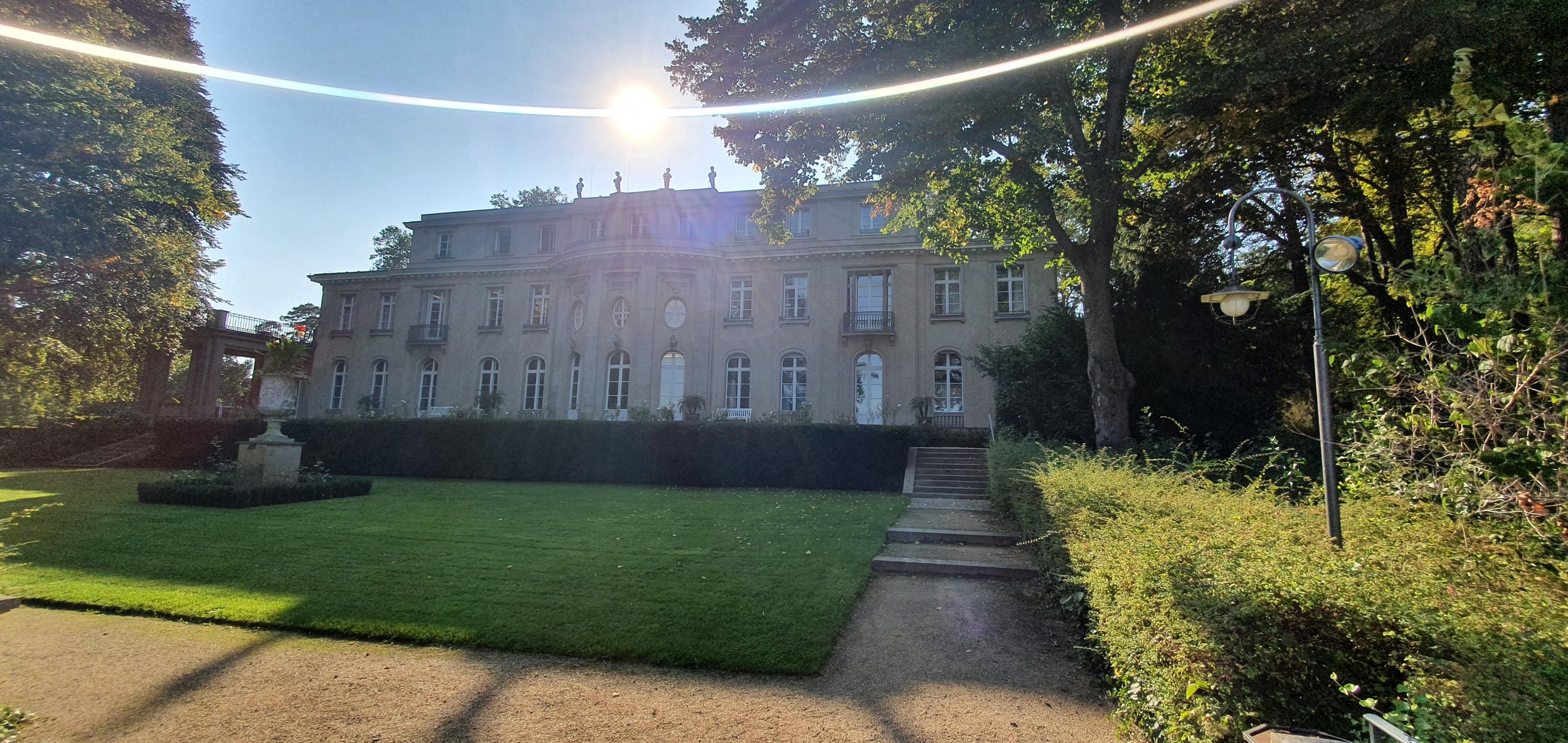
Just a formality?
The Conference
at Wannsee
The Wannsee Conference was a meeting of senior government officials of Nazi Germany and Schutzstaffel (SS) leaders, held in the Berlin suburb of Wannsee on 20 January 1942. The purpose of the conference, called by the director of the Reich Security Main Office SS-Obergruppenführer Reinhard Heydrich, was to ensure the co-operation of administrative leaders of various government departments in the implementation of the Final Solution to the Jewish Question, whereby most of the Jews of German-occupied Europe would be deported to occupied Poland and murdered. Conference participants included representatives from several government ministries, including state secretaries from the Foreign Office, the justice, interior, and state ministries, and representatives from the SS. In the course of the meeting, Heydrich outlined how European Jews would be rounded up and sent to extermination camps in the General Government (the occupied part of Poland), where they would be killed.
Discrimination against Jews began immediately after the Nazi seizure of power on 30 January 1933. Violence and economic pressure were used by the Nazi regime to encourage Jews to voluntarily leave the country. After the invasion of Poland in September 1939, the extermination of European Jewry began, and the killings continued and accelerated after the invasion of the Soviet Union in June 1941. On 31 July 1941, Hermann Göring gave written authorization to Heydrich to prepare and submit a plan for a "total solution of the Jewish question" in territories under German control and to coordinate the participation of all involved government organisations. At the Wannsee Conference, Heydrich emphasised that once the deportation process was complete, the fate of the deportees would become an internal matter under the purview of the SS. A secondary goal was to arrive at a definition of who was Jewish.
One copy of the Protocol with circulated minutes of the meeting survived the war. It was found by historian Robert Kempner in March 1947 among files that had been seized from the German Foreign Office. It was used as evidence in the subsequent Nuremberg trials. The Wannsee House, site of the conference, is now a Holocaust memorial.
Still taken from the Movie “Conspiracy” which details the conference
The Nazis did not record the exact date of their decision to annihilate all of the Jews in Europe, but historians believe this decision had been made by Hitler and the highest-ranking Nazi leaders by the end of 1941. Once the goal had been established and approved by Hitler, it was up to other German leaders to coordinate the details necessary to make it happen.
In January 1942, German officials, including representatives from the SS [the Nazis’ elite guard], the Einsatzgruppen, the Justice Ministry, the Office of the Governor General of Poland, and the Foreign Office, met in a lakeside neighborhood of Berlin called Wannsee. They had come to discuss the “Final Solution to the Jewish Question.” The highest-ranking German leaders—Hitler, Heinrich Himmler, Hermann Göring, and Joseph Goebbels—did not attend. Himmler’s deputy, Reinhard Heydrich, led the meeting.
Adolf Eichmann, the head of the Department for Jewish Affairs, prepared the minutes of the meeting based on a transcript made by a stenographer. He later revealed that the words he used to write up the minutes were not the words the participants had actually used. They spoke “in blunt terms” with “no mincing of words,” unlike Eichmann, who relied on euphemisms in the minutes:
In the course of this final solution of the European Jewish Problem, approximately 11 million Jews are involved. . . .
Under proper direction the Jews should now in the course of the Final Solution be brought to the East in a suitable way for use as labor. In big labor gangs, with separation of the sexes, the Jews capable of work are brought to these areas and employed in road building, in which task undoubtedly a great part will fall out through natural [means].
The remnant that finally is able to survive all this—since this is undoubtedly the part with the strongest resistance—must be treated accordingly since these people, representing a natural selection, are to be regarded as the germ cell of a new Jewish development.
In the program of the practical execution of the Final Solution, Europe is combed through from the West to the East.
At the time of the Wannsee Conference, the Nazis were already killing Jews in enormous numbers and by a variety of methods. Now that the destruction of European Jewry had become official German policy, the purpose of the Wannsee Conference, according to historian Doris Bergen, was to coordinate the details and establish the central role the SS would play:
The SS, Heydrich made clear, was in charge of destroying Jews, but other agencies and offices also had key roles to play. Moreover, by their very presence those bureaucrats, party functionaries, and occupation authorities demonstrated that they understood what was going on and endorsed it . . .
No one at the conference objected to the policy and practice of annihilation, although it was presented openly, starting with the announcement that Estonia was now "free of Jews." Instead participants spent their time on practical matters, above all on who would be included in the category of Jews to be “evacuated to the East” for killing. . . . This was the bureaucratic face of genocide, people’s lives and deaths reduced to categories and lists.
In 1942, the Nazi mass murder, especially of Jews, became more efficient. By spring of that year, the killing centers—camps designed not for imprisonment or forced labor but only for mass murder—were operating. By summer, Polish Jews living in ghettos were being transported to the killing centers. By the middle of 1943, Polish Jewry was mostly annihilated. Scholar Michael Berenbaum points out, “As these fifteen men gathered at Wannsee, four out of five Jews who were to be murdered in the Holocaust were still alive; fifteen months later in the spring of 1943, four out of every five were already dead.”
The Wannsee Conference lasted only 90 minutes. After the meeting concluded, Heydrich and Heinrich Müller, head of the Gestapo, asked Eichmann to join them for brandy and a cigarette. The three genocidists sat around the fireplace in the villa, smoking and drinking for a short while. As Eichmann later recounted, it was rare indeed to witness the austere Heydrich enjoying alcohol and a smoke. Yet for the Chief of Security Police and the SD there was much to celebrate. The gloating Heydrich realized that a system for destroying the entire Jewish people was settled. And it would operate under his leadership. He would report only to Himmler, who was responsible only to Hitler himself. Eichmann would manage this “Final Solution.” The assassination of Heydrich by Czech resistance fighters less than six months later did not halt what had been arranged at Wannsee.
There were some 30 copies of the 15-page Wannsee Protocol distributed within the various offices of the RSHA and the government ministries. Put together by Eichmann and marked “Secret Reich Matter,” Heydrich altered this document several times before it was circulated. Most of these copies disappeared during the war. Thankfully, as previously mentioned one was discovered in 1947 by the German-born lawyer, Robert Kempner, who had been expelled by the Nazis in the mid-1930s because of his Jewish origins. A translation of this copy, No. 16, which I have used for this article, is available at the website of the Memorial and Educational Site House of the Wannsee Conference (link at foot of page). Years later, in 1965, it was historian Joseph Wulf, a survivor of Auschwitz, who started the push for the villa to be preserved as a site of remembrance.
Extermination Camps
Following the Wannsee Conference, five additional extermination camps were adapted or established with the primary purpose of efficiently murdering the Jewish population of Europe.
This brought the total number of Nazi extermination camps to six. These extermination camps were:
Chełmno (in operation December 1941-January 1945)
Bełżec (in operation March-December 1942)
Sobibór (in operation May-July 1942 and October 1942-October 1943)
Treblinka (in operation July 1942-August 1943)
Majdanek (in operation September 1942-July 1944)
Auschwitz-Birkenau (in operation March 1942-January 1945)
The Attendees
The following persons took part in the discussion about the final solution of the Jewish question which took place in Berlin, am Grossen Wannsee No. 56/58 on 20 January 1942. Listed with their ultimate Fate.
SS-Obergruppenführer Reinhard Heydrich, Chief of the RSHA (Reichssicherheitshauptamt/ Reich Main Security Office) and Deputy Reich Protector of Bohemia and Moravia; ambushed in Prague on May 27, 1942 and died of his wounds on June 4, 1942.
State Secretary Roland Freisler, Reich Ministry of Justice; killed in an air-raid in Berlin on February 3, 1945.
SS-Sturmbannführer Rudolf Lange, Commander of the Sicherheitspolizei (Security Police; SiPo) and the SD for the General-District Latvia, Deputy of the Commander of the SiPo and the SD for the Reichskommissariat Ostland, and Head of Einsatzkommando 2; killed in action (or suicide) at Posen/Poznań, Poland on February 23, 1945.
State Secretary and Deputy Reich Minister Alfred Meyer, Reich Ministry for the Occupied Eastern Territories; committed suicide on April 11, 1945 near Hessisch Oldendorf.
SS-Gruppenführer Heinrich Müller, Chief of Amt IV (Gestapo) in the Reich Main Security Office; last seen in Berlin on April 30, 1945 – fate unknown.
Undersecretary of State Martin Luther, Reich Foreign Ministry; finished the war in a concentration camp after falling out with Foreign Minister Ribbentrop; died in Berlin of heart failure in May 1945.
SS-Oberführer Karl Eberhard Schöngarth, Commander of the SiPo (Security Police) and the SD (Security Service) in the General Government; hanged for war crimes (killing British prisoners of war) at Hameln Prison on May 16, 1946 (executioner – Albert Pierrepoint.)
Ministerial Director Friedrich Wilhelm Kritzinger, Permanent Secretary at the Reich Chancellery (representing Dr. Hans Lammers); acquitted of war crimes; died at Nürnberg on April 25, 1947.
State Secretary Josef Bühler, General Government (representing Governor-General Dr. Hans Frank); tried in Poland for war crimes and executed in Kraków, Poland on August 22, 1948.
State Secretary Erich Neumann, Office of the Plenipotentiary for the Four Year Plan; briefly imprisoned; died at Garmisch-Partenkirchen on March 23, 1951.
State Secretary Wilhelm Stuckart, Reich Interior Ministry; imprisoned for four years before being released for lack of evidence in 1949; killed in a car accident near Hanover on November 15, 1953.
SS-Obersturmbannführer Adolf Eichmann, Head of Referat IV B4 of the Gestapo; hanged at Ramla Prison in Israel on June 1, 1962.
Ministerial Director Georg Leibbrandt, Reich Ministry for the Occupied Eastern Territories; charged with war crimes but the case against him was dismissed in 1950; died in Bonn on June 16, 1982.
SS-Gruppenführer Otto Hofmann, Head of the SS Race and Settlement Main Office (RuSHA); sentenced to 25 years in prison for war crimes, but was pardoned in 1954; died in Bad Mergentheim on December 31, 1982.
Ministerial Director Gerhard Klopfer, Permanent Secretary of the Nazi Party Chancellery (representing Martin Bormann); charged with war crimes but released for lack of evidence; died on January 29, 1987.
Click on Picture for PDF of Minutes of the meeting.
Click to view on my photos of Wannsee from September 2020
Watch the History Pods brief video on he Conference
Conspiracy movie review in 3 minutes
A preview of the 2022 German Movie “The Conference”







